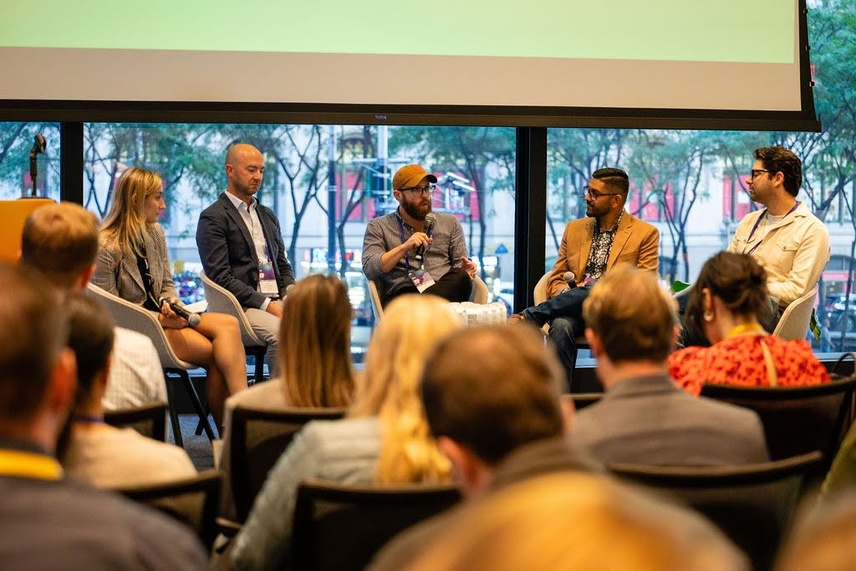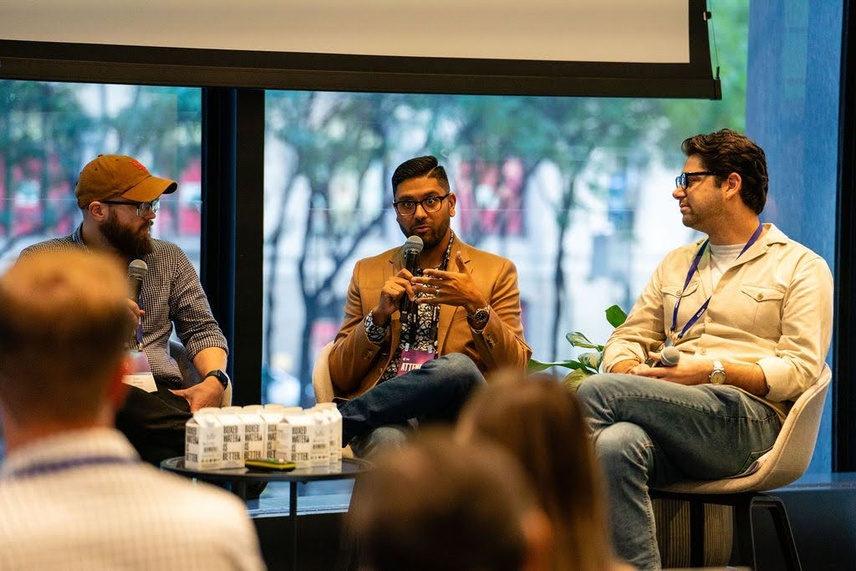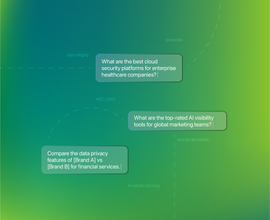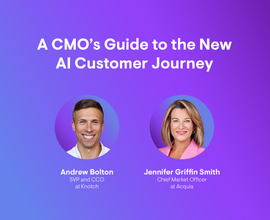5 Strategies for AEO / GEO Success
Want to know what's actually working for AEO / GEO today? We gathered insights from a C3 panel featuring experts from Boston Globe, SELG Consulting, Uberall, and Datadog who are navigating this shift firsthand. They tackled the big questions—how to optimize for conversations instead of keywords, manage bot access without losing visibility, and measure success beyond traffic metrics.
You'll also get the honest perspective on AI search traffic volumes (spoiler: it's still a fraction of total traffic for most) and where brands are investing their efforts for 2026. If you're wondering whether to overhaul your entire content strategy or just want tactical next steps, this recap has you covered.
AI search is reshaping how consumers discover brands, but most companies are still figuring out what actually works. The landscape is evolving fast, and the strategies that drive visibility today look different from traditional SEO playbooks.
These takeaways are from a panel at C3 2025, New York’s premier AEO / GEO conference, brought to you by Conductor, featuring the following guests:
- Marc Choquette, Director of SEO at Boston Globe
- Sacha Goureau, Founder of SELG Consulting
- Partho Ghosh, VP of Product at Uberall
- Eric Brown, Demand Generation Manager at Datadog
- Sarah Corbett, Senior Manager of Account Management at Conductor
These are the top 5 must-know strategies for achieving AEO / GEO success:
- Don't abandon SEO fundamentals: AI search still represents less than 10% of traffic for most brands, while Google remains dominant at nearly 90%. Double down on what's working before chasing the next big thing.
- Optimize for conversations, not just keywords: Users engage with AI search differently, conducting deeper research sessions and asking more complex questions. Content needs to support full conversational flows, not single queries.
- Be strategic with bot access: Block training bots to protect your content from being used to train AI models, but allow retrieval bots so you can appear when users search for you. Understanding bot purposes is critical.
- Focus on quality over volume: AI search traffic arrives less frequently but converts at significantly higher rates because users come more informed and ready to make decisions.
- Measure what actually matters: Track engagement rates, conversion performance, and citation frequency—not just traffic volume. Invest in visibility tools that help you understand what's working in AI search.

Don’t abandon the SEO fundamentals
Let's address the question everyone is asking: How much traffic is AI search actually driving?
For most brands, the answer is sobering. AI search still represents a tiny fraction of total traffic—often less than 1% for publishers and in the single digits for B2B companies. Google continues to dominate, driving nearly 90% of search traffic for many organizations.
There's so much hype around this right now with the AEO / GEO. I'm going to caution everyone to pump the brakes a little bit. I was just doing an analysis for our senior leadership team and looking at, when you factor in all search platforms, where is our traffic still coming from? And it's still almost 90% Google. LLMs are like 0.1% of our traffic.
The message is clear: If anyone claims they've "cracked" Answer Engine Optimization, that's a red flag. Everyone is still figuring this out, and the vendor ecosystem is flooded with VC money making big promises they can't keep.
It's funny—the winning strategies, we're all trying to win. Nothing's won yet—it's constantly evolving.
But here's where it gets interesting—the numbers vary dramatically by industry.
Some B2B companies see AI search traffic in the single-digit percentage range, significantly higher than publishers' traffic, but still a fraction of total traffic. What matters more than the volume, though, is the quality.
We see that users who come in via ChatGPT or Perplexity are primed to convert at significantly higher rates than through Google. Because yeah, they've done their research through these tools. And so what's being replaced is that more upper funnel content.
Users arriving from AI search have already done extensive research. They're asking sophisticated questions, comparing options, and ready to make decisions. This fundamentally changes how you should think about AI search traffic—it's less about volume and more about quality and intent.
An important warning about priorities:
The biggest mistake is forgetting about the SEO side. Google is changing based on all this stuff. Whether they're reacting [defensively] or on the offensive side, they're changing. And they're going to change based on that. I think not looking at what they're doing and reacting to that more so than AI search might hurt you more in the short term, in my opinion.
The message? Don't completely abandon what's still driving the vast majority of your traffic while chasing the next big thing.
Optimize for conversations, not just keywords
Consider this: What's the single biggest shift you've made to show up in AI search engines?
AI search requires a fundamentally different approach to content optimization. Traditional SEO focused on single keywords and quick answers. AI search demands content that supports deeper, more conversational queries, where users are having extended research sessions rather than one-off searches.
The one thing I think that has been a shift for us is no longer optimizing for keywords but for conversations. Google was more about single keyword optimization, quickly finding the answer to the question that you're looking for. Here, we're going much deeper into the conversation.
For organizations adapting to this shift, the starting point is understanding what users are actually asking. Rather than building content around keywordKeyword
A keyword is what users write into a search engine when they want to find something specific.
Learn more targets, successful brands are:
- Analyzing the actual prompts users enter into AI search engines
- Structuring content to answer follow-up questions that naturally arise in conversational flows
- Adding FAQ sections that address specific concerns within broader topics
- Incorporating listicles and clear answer formats that AI engines can easily parse and cite
The types of content that drive results are evolving. Previously, teams invested heavily in top-of-funnel, definitional content to build non-brand visibility. Now they're refocusing on brand-oriented content—how users compare products, evaluate solutions, and research competitors.
The reason? Users coming from AI search engines have already done their preliminary research. They're asking more sophisticated questions and arriving with higher intent.

Be strategic with bot access
Which AI bots should you allow, and which should you block?
When AI search first exploded in popularity, many brands defaulted to blocking everything. The reasoning was sound—they'd been burned by platforms before and wanted to protect their content from being freely used to train AI models.
A more nuanced approach has emerged. Understanding what different bots actually do—using tools like Dark Visitors to distinguish between bot purposes—is now essential for making strategic decisions.
The key takeaway? Not all bots serve the same purpose.
One of the things we're seeing is that as these LLMs evolve, they're becoming more nuanced in how they crawl, and they're using different bots. Now we're seeing more nuance where there's a specific bot that OpenAI has to retrieve information based on a prompt. And that's separate from the one that's used to train its LLM.
The strategic approach many brands are now taking balances protection with visibility—blocking training bots to prevent content from being freely used while allowing retrieval bots so brands can appear when users specifically search for them.
It's about being strategic rather than reactionary, understanding the purpose behind each bot, and making intentional decisions about access.
Focus on quality over volume
The pressure to adapt to AI search has many brands wondering if a complete content overhaul is necessary. Here's the good news: you don't need to burn everything down and start from scratch.
Rather than creating entirely new content libraries, the strategy is to take existing high-performing content and add "layers of AI-ified signals" that help LLMs understand, process, and cite it.
What does "AI-ifying" content actually mean?
- Adding comprehensive FAQ sections that answer specific user questions
- Pulling in expertise from different parts of the organization to demonstrate E-E-A-T
- Structuring information to support conversational queries beyond the primary topic
- Creating content that addresses the full customer journey, not just a single search intent
We took the approach of, instead of saying, hey, we need new content for everything, let's look at what's working well today within the principles of search and SEO, and how do we add in layers of AI-ified signals for LLMs.
Beyond optimization, two factors are non-negotiable: freshness and consistency. Content must be up-to-date and consistent across all platforms where your brand appears. Inconsistent information confuses AI engines and hurts your chances of being cited. If you control your brand narrative through accurate, current content, AI engines will reflect that. If you don't, they'll fill in the gaps themselves.
If you don't own your brand, AI will own it for you.
This matters especially as AI-generated content floods the web.
It's a meta world right now. We see so much content that's being created by AI for AI to read. It's a really funny situation. But I think making that content as human as possible and proofreading it—that's what we're telling our customers... You should look at [AI-generated content]. Don't just blindly trust it.

Technical SEO still matters (maybe more than ever)
While much of recent conversation around AI search focuses on content, technical fundamentals deserve equal attention—perhaps even more than before.
Here’s the reality: Not all LLMs are great at crawling the web. They crawl less efficiently than traditional search engines, frequently encounter errors, and struggle with technical issues that Google's sophisticated crawlersCrawlers
A crawler is a program used by search engines to collect data from the internet.
Learn more handle with ease.
This makes accessibility paramount. The approach centers on making content as accessible as possible—or as some put it, "putting the cookiesCookies
Cookies are small text files that are saved on a user’s local computer when browsing and sent back to the server when the user visits the same sites again.
Learn more on the bottom shelf." This means doubling down on technical SEO basics:
- Implementing comprehensive schema markup to help AI engines understand content structure
- Ensuring everything is server-side rendered for easy access
- Optimizing site performance across the board
- Making content as accessible as possible for AI crawlers to understand and retrieve
Monitoring bot behavior through server log analysis adds another layer of insight. Understanding which pages AI bots crawl most frequently—and ensuring those pages contain accurate, up-to-date information—proves incredibly valuable for optimization efforts.
I think it's also interesting, not just making sure that the crawlers are reading your content. but the right content.
The takeaway for marketers? Technical SEO isn't just about traditional search engines anymore. The same principles that help Google understand and crawl your site are even more critical for AI engines that aren't as sophisticated at navigating complex web architectures.
Measure what actually matters
Understanding what's happening in AI search requires the right tools—but tools alone aren't enough. The most valuable insights often come from becoming a user yourself. Search for your brand in ChatGPT and Perplexity. See who's showing up, how they're showing up, and what content is being cited. Then reverse-engineer the journey.
This hands-on approach reveals something critical: traditional metrics might not tell the whole story. If impressions are going up but clicks are going down, are you capturing the full picture of your AI search performance?
Metrics worth tracking beyond traffic volume:
- Engagement rates on AI-referred traffic
- Conversion rates compared to traditional search traffic
- Time on site and content consumption patterns
- Citation frequency in AI responses
The emerging picture suggests that AI search traffic may arrive less frequently, but when it does, it's more valuable—more engaged, informed, and ready to convert.
In summary
So, where should you place your strategic bets for the coming year? The answer varies based on your unique business context, but several approaches are emerging as priorities:
- Invest in visibility tools and consumer-first testing. Be the user. Understand the experience before you try to optimize for it. Work with the right measurement platforms to track your performance and make data-informed decisions about where to invest your efforts.
- Watch the rise of community platforms. An unexpected trend is emerging: the growing importance of community platforms like Reddit for AI search visibility. As AI engines increasingly pull from diverse sources to generate responses, building an authentic brand presence across these channels is becoming more critical.
- Monitor crawler behavior and optimize strategically. By understanding which pages AI bots access most frequently and what queries they're serving answers for, brands can strategically improve those pages to deliver better, more accurate responses.
- Consider diversification over dependence. Rather than doubling down on search dependence, some brands are focusing on building direct relationships with audiences through product innovation and user experience improvements.
While these approaches may point you in the right direction, there is no single "winning strategy" for AI search visibility—at least not yet. The brands that will succeed are those that stay curious, stay measured, and stay grounded in the basics while thoughtfully experimenting with new tactics. Nothing has been won yet. The game is still being played, and the rules are still being written.
Marc Choquette, Sacha Goureau, Partho Ghosh, Eric Brown, and Sarah Corbett shared these insights and more during their C3 2025 session, Winning Strategies to Enhance Your Visibility in AI Search—watch the full recording below.
This article is based on insights shared at C3—New York’s premiere AEO / GEO conference—brought to you by Conductor, and has been adapted for clarity and depth.

![Marc Choquette, Director of SEO, [object Object]](https://cdn.sanity.io/images/tkl0o0xu/production/a378b22a053e79422a48561577464a11d87ce6a5-3024x3024.jpg?fit=min&w=100&h=100&dpr=1&q=95)
![Sacha Goureau, Founder, [object Object]](https://cdn.sanity.io/images/tkl0o0xu/production/fd4b53f24a5bc59c0631d21c1015ad7c016b7f9d-595x595.jpg?fit=min&w=100&h=100&dpr=1&q=95)
![Eric Brown, Demand Generation Manager, [object Object]](https://cdn.sanity.io/images/tkl0o0xu/production/b1b72bdf9d6b1c3b661ef689293d12ea414b2158-800x800.jpg?fit=min&w=100&h=100&dpr=1&q=95)
![Partho Ghosh, VP, Product, [object Object]](https://cdn.sanity.io/images/tkl0o0xu/production/9b4c5b3d4f9fd616f3449359c0ed20243b1c5dce-720x699.png?fit=min&w=100&h=100&dpr=1&q=95)






